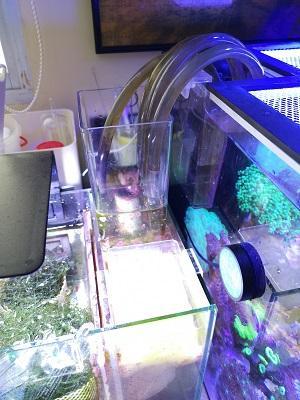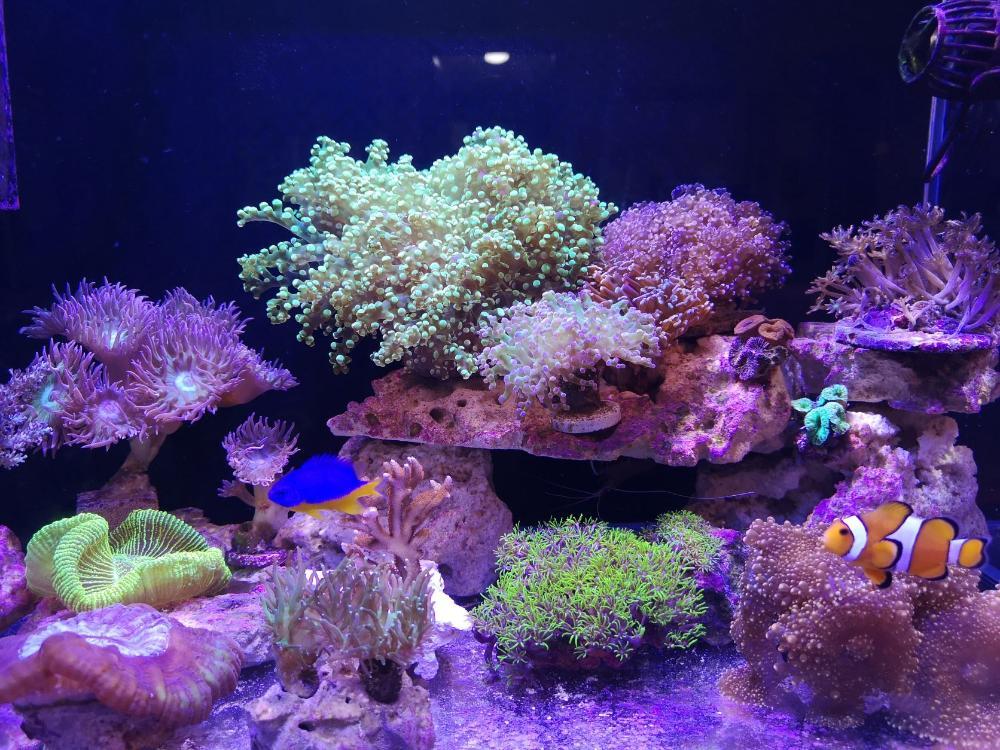-
Posts
18 -
Joined
-
Last visited
Profile Information
-
Country
Singapore
-
Interests
Photography, Singing, Cars, Travel, Books
Recent Profile Visitors
The recent visitors block is disabled and is not being shown to other users.
CharlieBrown's Achievements
-
I have also switched to a Hanna HI98319. Its much easier and convenient to use. The principle is indirect measurement but because it is so consistent, coupled with intermittent calibration (I do it about every 2 months), the accuracy is very acceptable for hobbyist like us. Definitely more reliable than the swingarm and the common optical refractometers (very wide quality variations and calibration always run-off for some reason, so even though theoretically these are accurate, mfg quality makes them very unreliable IMO). If you want highest accuracy (and quality), then the Hanna HI96822 (optical digital refractometer) is a great choice (but IMO not required) On a related note, besides salinity, I find that accurate measurement and stability of alkalinity is also critical as corals consume them quite fast if you have many of them in a tank. A Hanna alkalinity checker is also great. The rest like NO3 and PO4, you can use Nyos kits which are decently good (of course you can also get digital checkers like Hanna as well if cost is not an issue). For me, I am a low tech hobbyist and able to monitor the salinity and alkalinity are crucial for success in low tech tanks.
-
I did. But not the pvc pipe type. using 2 raided kitchen acrylic containers (14x10x8cm). Had it for more than a year now and running well. Btw my sump is also DIY from a smaller tank (20L) and placed on the same table as my DT (60L) for easy monitoring and maintenance purposes. Sump pump is 1000L/hr flow rate at max) Not the best looking but I works well. Intend to do a better version using acylic sheets for both the boxes as well as the overflow channel (instead of tubings)
-
Nice. I too had a suicide jumper fire goby. I did the same but using PVC foam (from online) and laundry netting from Daiso.
-
Checking in after many months Had made some adjustments to my nano tank routine to made my hobby more sustainable. Key changes made are : Go without sand (bare bottom) - best impact to keep nitrate/phospate/cyano at bay. My tank and sump are now coraline algae dominated. DIY a bigger sump with skimmer added. Harvest about 1 fistful of chaeto every 2 weeks. Stopped H2O3 dosing as it decimates my pod population (also not needed as zero cyano). Zero supplements, just 10% water change every 2 weeks. Dose with baking soda (my tank uses ~0.4 kH daily, I add this amount daily to have stable alkalinity) Using a better alkanity tester like Hanna - for above purpose. (Still struggling to have nice landscape - could never get close to the tank scape I see everywhere else) My approach is still low tech. Just added a SPS to see how it fair. Next planned changes will be my lights and better testers (if I add more SPS)
-
CharlieBrown changed their profile photo
-
After 5 months. Sent from my CLT-L29 using Tapatalk
-
Hi, need help to ID what is this whitish patch on the rock? Sent from my CLT-L29 using Tapatalk
-
Owned a marine FO tank 3 decades ago and since then only planted tanks. With more time on my hands now, decided to try something new; a reef tank. Intend to keep things basic & simple thus a nano tank. As I have zero knowledge about corals, it will also be a trial and error process. Re-used an old 50L tank as DT with a DIY sump and OF blox. The sump is placed on the same table as the DT to facilitate easy access and maintenance. Making it visible means I will make the effort to clean, maintain and keep it tidy (visual management) It’s a basic setup with no skimmer, relying on weekly approx. 15% water changes (about 7L, only a small pail of water). Filtration is wool, purigen and a bag of siporax and coral chips each. Water testing is just salinity and nitrate. Will be removing the coral chips soon as I understand it is of no help in buffering the kH due to the high pH of saltwater and a potential nitrate factory. (let me know if anyone has a different opinion) Set it up since early Aug. Equipment and setup 5kg of Caribsea rocks (not live rocks) and a thin layer of live sand. I made the mistake of stacking the rocks too high, thus unable to put larger or taller corals on top of the rock scape. Lighting is re-using a Chihiros A301 full spectrum plant light with the addition of a low cost FROK LED blue strip light to evaluate if a dedicated and rather expensive reef lights are a must for easy corals. I won’t recommended the FROK light as 2 drivers failed me in 2 weeks. In the end I adapted an old laptop charger to drive it and is working well now. Plant light is at set 20% (to have a good balance with the blue light) and photoperiod is only 4.5hrs daily (photoperiod seems low compared to what I read but the corals seems happy at the moment and growing. Thinking of extended by an hour or 2 but split the photoperiod apart like what I did for my planted tank so that I can enjoy the tank for longer period without algae growth. Chiller is 1/10 HP at 26 deg. For those interested, it is much cheaper than the Hailea (by about 30%) and though too early to tell, working well. Noise level could be a little quieter but then, I have it in the open and not in a cabinet. (Sold by a hobbyist in Carousell. Search around for “AL 160 chiller” and you’ll find he organize mass buy for it regularly) An inline UV light is installed fitted with a second pump with low flow. It is usually considered as optional equipment but to me, I find them useful and beneficial (in conjunction with H2O2 dosing to keep diatoms, dinos and free swimming parasites at bay) It is link to the tank’s lights’ timer (4.5hr). After trying out 2 swing arms, floating tube hydrometers and 2 optical refractometers, I gave up on all these and bought a Hanna salinity meter. It gives me a good peace of mind. I do have a mini skimmer but only on standby. Tried it for a few days but it pulled nothing. Anyway as I am using water change as the main method to export nutrients, its not really needed on top of opinions I read that it pull out trace elements. 2 tiny wave makers to push water around. Just setup a quarantine tank as I will be adding fishes in a few weeks time. Last but not least, a self-assembled RODI system for top up and water change. Am reading up on the best and shortest period to quarantine. I find the typical 30days period really torturous for the fish and I. If any of you have neat tricks/cheats (reduce to 10 days?), please offer your tips. In the tank Fishless at the moment as I wanted to have all the corals in first (still adding slowly) Torch, Hammer, GSP, Cauliflower (not sure about the name but its pink), leather, brain, candy cane, mushroom and 1 snail. In the past 2 weeks large numbers of copepods and then amphipods appears in the DT. Am told it is healthy and quite ready for fish. All tank inhabitants seems happy except for the leather. Hardly see its tentacles. Its like a big piece of smooth leather most of the time. It is also the biggest in the tank so don’t look too good. Am thinking of chopping it up (“fragging” is a new word for me) never done that before and seems interesting. Bought some Caribsea frag rocks and will attempt it soon Feeding on alternate days with Reef Energy AB+ and Seachem Phytoplankton. Some sinking pellets for the torch, hammer, brain randomly). Have not decided on feeding regime once I add fish. Intend to reduce but not sure by how much (advise appreciated). Intend to add maybe another 4 to 5 corals as you can see it is still quite bare (if you have some nice frags that you think will add colour and diversity to my tank, please private message me. No SPS though, not confident of it yet) As for fishes, maybe just 3 to at most 4 small fishes. (Clown, blenny, Gramma, Dartfish) and maybe a couple of cleaner shrimps. I am very tempted to have just 1 flame angel in lieu of all the rest of the fishes but read that it is not reef safe. If anyone is successful with a flame angel in a nano tank with corals, please share how you manage to do it. Maintenance Regime Daily : wash filter wool, top up water. Dosed with 1.5ml H2O2 daily (started since 3rd week after setting up when a light coating of diatoms appear). Intend to taper off the dosing in the next 2 weeks as diatom gone and green spots of algae are appearing in the tank (not nuisance algae as far as I can tell) Weekly : Clean DT glass and sump, remove 7L of water (including siphoning of sandbed) and rinse very lightly the siporax and coral chips in the removed water. Monthly : Add Dr Tim’s waste away a couple of days before doing the weekly cleaning as above. Might add Reef Plus and Reef Trace on a monthly basis since water change is only 15%. Not started yet, maybe when I feel I have enough corals added. I only tested for nitrate so far and don't intend to test for all the other stuff if I can avoid it Issues encountered/mistakes made Sump can be bigger and better constructed to make cleaning easier and more space for equipment and potential refugium (will be doing a sump 2.0 in a couple of weeks time) Did not quarantine my 1st couple of corals and one of them had about 10 small aiptasia. Manage to kill them all fortunately (Take it out, dig deep and dig out the aiptasias and soak coral in strong mix of H2O2 (50/50) Added a camel shrimp that attack my candy cane and took out a chuck of the brain. Was a nightmare to catch it. Having the salinity wrong from the inaccurate refractometers. No idea why as this is a common tool. Maybe the ones I got (2 in total) are junk quality. Likewise 2 swing arms gives 2 different readings. Stacked rocks too high, unable to put larger corals on top of it. The most stupid mistake ever made (don’t laugh) is I thought I bought a coral when it is a anemone. What a joke. Manage to return it but super embarrassed. I am still learning about corals. That’s it. Hope other newcomers and experienced reefers can offer your advise and insights to my nano reef keeping journey. Attached a short clip of my tank. VID_20201002_225314.mp4
-
I am thinking of using it for the equipment which runs off our AC such as chiller, lights, sump pumps and filters. Maybe I can make do with ice packs in an emergency (as the chiller sucks the most juice) and lights are not a concern but power is crucial for the sump pumps and filters (reef and planted tanks). The wavemaker do have DC input but its not critical as well as long as sump pump are running. My friend had a blackout once for about a day (they were not at home) and it was horrendous (partly because he has highly stock ref tank)
-
Anyone using a UPS backup? There are quite a number of brands and pricing. Saw one brand "APC" which is priced quite reasonably compared to others. Anyone with user experience and recommendation? Looking at around 1000 VA which can handle approx 4hrs backup. Thanks
-
I am adding corals gradually to my new tank and use a small quarantine tank to observe if the corals have aiptasia or other pests. Once I see it, I take it out, use a swiss army knife to dig it out (and dig deep too) and after that soak the coral in Hydrogen peroxide/tank water 50/50 for 1 min (bought from Guardian 3% in 500ml bottle), rinse it and then put it back into the quarantine and check again to ensure they are gone. Manage to took out a colony of about 10 aiptasia (repeat 2 time as did not get them all in the 1st and 2nd attempts). Can't imagine what will happen had I just add the coral directly to my tank. I try to soak only the affected areas and not dunk the whole coral but there videos on the net where people soak the whole coral for 2mins in straight H2O2 @3% and coral is still fine (but not for certain corals like Xenia and Gonio and probably more). I prefer 50/50 and not dunking it as I can see the oxidising effect already within seconds of soaking it in 50/50. Reason for soaking is to kill any aiptasia cells that might have been left behind. I also dose H2O2 in my tank and for fish quarantine too but that's another story.
-
The amount of technology and techniques available to us are tremendous and thus expensive, not to mention a huge amount of time is also required. Anyone here successful in keeping it simple (essentials) with regards to equipment and husbandry for the long term (say more than 2 years)? Can you share your secrets and also comment if my below is viable for the long term with lps+low fish stocks ? (just got back to this hobby) - a chiller and sump with some siporax, coral chips, purigen - basic reef lights (currently testing out with my old plant lights with actinics added-on) - regular water change of 10% a week using RO/Salt No reactors, no dosing, no additives, generally no testing (except for the occasional 6-in-1 litmus dip for NO2, NO3, pH, KH, GH, Cl) The only addition planned is a skimmer down the road.
-

Heating and cooling chiller
CharlieBrown replied to Muayad's topic in New to the Marine Aquaria Hobby
Heating and cooling? If your tank is at home, a chiller is sufficient. Even if you turn on your aircon 24x7 a heater is not required unless it is freezing cold. As for brands there are a few common ones you can find in most marine aquarium shops such as Arctica, Teco, Hailea. -
Need some opinions regarding the above Online shops like Lazada, Shopee are selling a OEM type costing around $30, with a pump of 3.5W and a overall size of 22cmx9cmx5cm. Sold under many different brands but looks exactly the same (see pic) Anyone have experience with this or a good recommendation of about the same size (and where to get it)? Preferred powered instead of air driven. Also, I already have a daylight dimmable LED for plants. I am thinking of continue using it and add a small clip-on the back actinic light (LED or PL) instead of getting a completely new reef lights. Anyone done the same and any recommendation of the actinic? Keeping some LPS only and currently they seem to be doing fine (too early to tell) with the plants light. Tank size is only 50L Thanks
-
Here's how it's working. Going to hijack my son's larger tank to make sump 2.0 VID_20200825_113356.mp4




